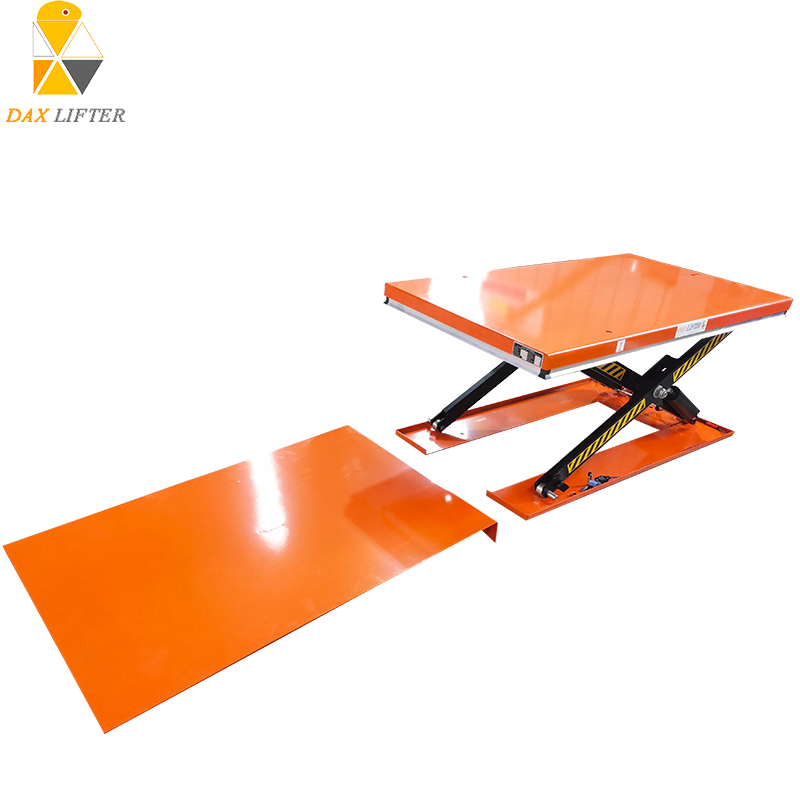Hydraulic Low-profile Scissor Lift Platform
Hydraulic low-profile scissor lift platform is special lifting equipment. Its distinctive feature is that the lifting height is extremely low, usually only 85mm. This design makes it widely applicable in places such as factories and warehouses that require efficient and precise logistics operations.
In factories, ultra-low lifting platforms are mainly used for material transfer on production lines. Due to its ultra-low lifting height, it can be easily used with pallets of various standard heights to achieve seamless docking of materials between platforms of different heights. This not only greatly improves production efficiency and reduces the labor intensity of manual handling, but also effectively avoids damage and waste caused by improper material handling.
In warehouses, ultra-low lifting platforms are mainly used for material access between shelves and the ground. Warehouse space is often limited, and goods need to be stored and retrieved efficiently and accurately. The ultra-low lifting platform can quickly and stably lift goods to the height of the shelf, or lower them from the shelf to the ground, greatly improving the efficiency of goods access. At the same time, due to its ultra-low lifting height, it can also adapt to different types of shelves and goods, showing extremely high flexibility and versatility.
In addition, the ultra-low lifting platform can also be customized according to the actual needs of users. Whether it is lifting speed, carrying capacity or control method, it can be adjusted and optimized according to specific application scenarios. This high degree of customization allows the ultra-low lifting platform to better adapt to different factory and warehouse environments, providing users with more personalized solutions.
Technical Data
|
Model |
Load capacity |
Platform size |
Max platform height |
Min platform height |
Weight |
|
DXCD 1001 |
1000kg |
1450*1140mm |
860mm |
85mm |
357kg |
|
DXCD 1002 |
1000kg |
1600*1140mm |
860mm |
85mm |
364kg |
|
DXCD 1003 |
1000kg |
1450*800mm |
860mm |
85mm |
326kg |
|
DXCD 1004 |
1000kg |
1600*800mm |
860mm |
85mm |
332kg |
|
DXCD 1005 |
1000kg |
1600*1000mm |
860mm |
85mm |
352kg |
|
DXCD 1501 |
1500kg |
1600*800mm |
870mm |
105mm |
302kg |
|
DXCD 1502 |
1500kg |
1600*1000mm |
870mm |
105mm |
401kg |
|
DXCD 1503 |
1500kg |
1600*1200mm |
870mm |
105mm |
415kg |
|
DXCD 2001 |
2000kg |
1600*1200mm |
870mm |
105mm |
419kg |
|
DXCD 2002 |
2000kg |
1600*1000mm |
870mm |
105mm |
405kg |
What is the maximum load capacity of the ultra-low lifting platform?
The maximum load capacity of an ultra-low lift platform depends on several factors, including the platform's size, construction, materials, and the manufacturer's design standards. Therefore, different ultra-low lifting platforms may have different maximum load-bearing capacities.
Generally speaking, the maximum load-bearing capacity of ultra-low lifting platforms ranges from hundreds to thousands of kilograms. Specific values are usually stated in the device's specifications or in the documentation provided by the manufacturer.
It should be noted that the maximum load-bearing capacity of an ultra-low lifting platform refers to the maximum weight it can bear under normal working conditions. Exceeding this weight may result in equipment damage, reduced stability, or even a safety incident. Therefore, when using ultra-low lifting platforms, the manufacturer's load limits must be strictly observed and overloading must be avoided.
In addition, the maximum load-bearing capacity of the ultra-low lifting platform may also be affected by other factors, such as the working environment, working frequency, equipment maintenance status, etc. Therefore, when selecting and using ultra-low lifting platforms, these factors need to be considered comprehensively to ensure the safe and stable operation of the equipment.









